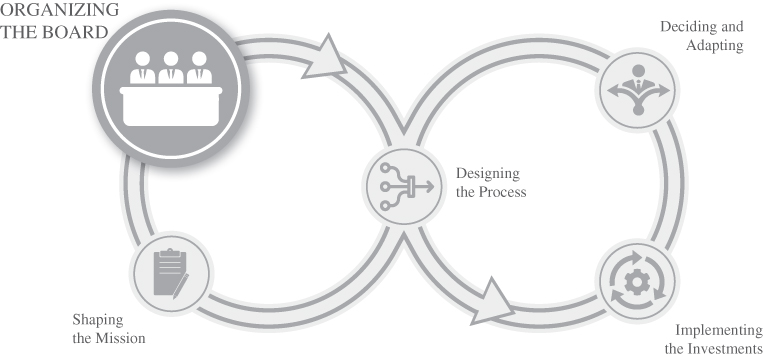PART Four
Organizing the Board

This section looks at the pension fund board from all angles. What are the characteristics of boards and their members, what should pension participants expect from them, how do members operate on boards, what attributes do board members need and how do they organize themselves?
Just as a new trustee would also do, we commence our examination of the pension fund board by reviewing the roles and responsibilities of the board and the characteristics of members, as well as by identifying the characteristics of successful boards and board members. This discussion is centered on maintaining “the right altitude—the right distance—the right horizon” for developing and monitoring the implementation of the strategy.
We examine the roles of boards as collective entities, as well as the parts that individual board members play. The way these members serve on a board, both individually and collectively, makes or breaks the quality of the outcome. Board member competence and knowledge is obviously an asset, but the selection process also highlights managing or representing different stakeholder groups as an important part of the required profile. How do board members balance these different interests?
Next, we move on to the roles and organization of the board staff or executive office, which is close to the board and supports board members in the formulation and evaluation of their strategy. The staff makes sure that the strategy is implementable in a practical way, taking into account the goals and framework set by the board. Reciprocally, the staff aggregates information so as to allow the board to monitor effectively and at the right altitude.
Thirdly, we consider the investment committee, the board's important subcommittee that deals with investment matters.
Lastly, we will have a look at the investment organization (or pension delivery organization) that is responsible for implementing the (strategic) investment plan and is often intimately involved in advising on the investment strategy. The cooperation between the pension fund and the investment management organization requires some forethought to ensure clear roles and responsibilities, as well as mutual trust and smart countervailing powers to maintain the right balance.
Part IV Topics Include:
- What are the key characteristics of an effectively functioning board?;
- What is the “governance budget?;”
- How to identify a board's weaknesses and improve it over time;
- How to prepare for and organize a well-run investment committee;
- How you, as a board member, and the board as a whole, can get a grip on the investment management organization.
CONTRIBUTION OF THIS PART TO INVESTMENT EXCELLENCE
Part IV focuses on the board. The contribution of individual board members, and the board as a whole is often overlooked because discussions and choices tend to be “soft” in nature, while investment theory and advice typically looks at investing as a hard-wired problem that can be solved objectively. Next to that, it can be very challenging to reflect on one's own role when it comes to potentially not realizing excellence. Both the qualities, the knowledge and the competences of the individuals involved and the way the cooperate within the board are important drivers of excellence. A special position is taken by the chairman of the board of the pension fund. Working towards excellence can be done in many ways and starts with understanding the challenges and properly organizing the investment committee meetings. Putting together the right set of individuals may take significant time and planning.
